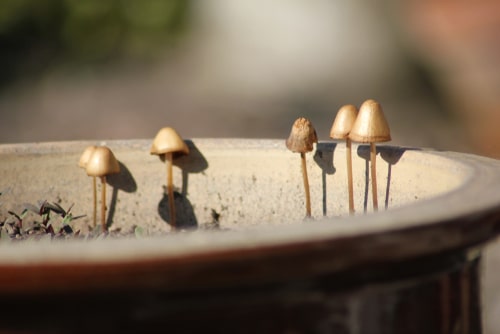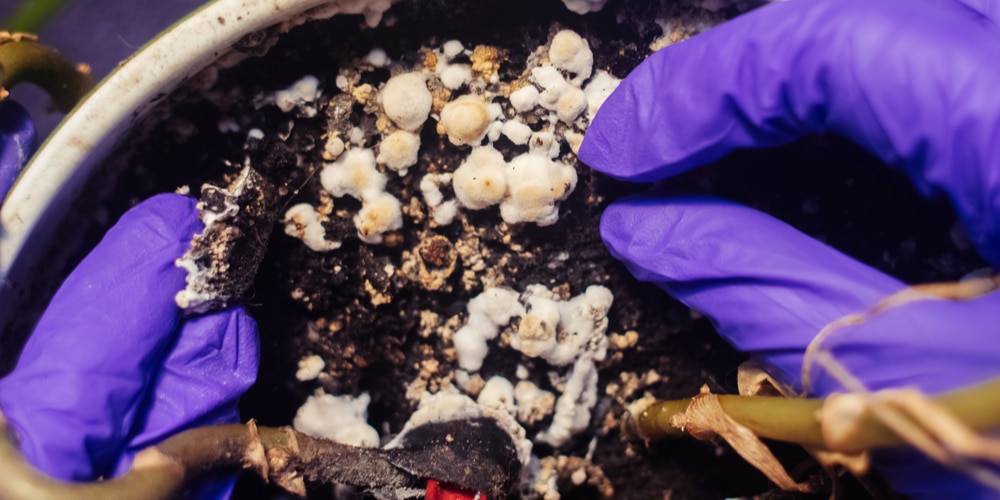If you’ve ever found a brown mushroom growing in your potted plant, you may be wondering what it is and if it’s harmful. In this article, we’ll take a closer look at mushrooms growing in potted plants and answer some of the most common questions about them.
What type of mushroom is it likely to be?
There are lots of different types of mushrooms that would grow in a potted plant, and each type may need different handling.
For this reason, you should try to identify the type of mushroom growing in your plant’s pot. This will help you determine whether or not it’s harmful and what, if any, steps you need to take to get rid of it.
Whenever you spot small, brown mushrooms that have long, conical caps, they most likely belong to the Coprinus genus. These are the most commonly spotted in potting soil.
It’s, however, not off the wall to come across mushrooms from the Conocybe genus. These have caps that are darker and slightly flatter. There are cases where you may also come across other species of brown mushrooms in an indoor setting.
In the majority of situations, brown mushrooms growing in a potted plant are not toxic. You will, all the same, still want to get rid of them for aesthetic reasons.
Why mushrooms grow in potting soil
Mushrooms often grow in potting soil because it contains the right combination of ingredients that they need to thrive. Some of these include:
-Organic matter:
This could be in the form of dead leaves, compost, mulch, or wood chips. There are some fertilizers that can also provide the nutrients that mushrooms need to grow.
-Moisture:
Mushrooms need moisture in order to grow. This is why they’re often found in damp, dark areas like forests or basements. If the potting soil in your plant’s pot is too dry, the mushrooms will not be able to grow.
-Temperature:
Mushrooms need a warm temperature in order to grow. This is why you’re more likely to find them growing in the spring and summer months.
How mushrooms spread
Mushrooms can spread in a few different ways.
The most common way is through spores, mainly in an outdoor environment. These are tiny, dust-like particles that are released by the mushroom. They can travel through the air and land in other areas, where they will start to grow.
In an indoor setting, in contrast, it’s almost impossible for spores to spread through the air. In rare cases, lawn mushrooms might be able to find their way into your house through ventilation systems or open windows. Besides, houses are often too warm for spores to survive.
Having considered that, indoor mushrooms will more than often come from the potting soil itself. You could have inadvertently brought them in on new plants or potting soil that you’ve bought. That’s possible especially due to the reason that there are fungal spores that can lie dormant for years, only to start growing when the conditions are right.
Another way that mushrooms can spread is by animals and humans tracking them in from the outdoors. This is more common in areas where there are already a lot of mushrooms growing.
Are houseplant mushrooms harmful?
In general, mushrooms that grow in potting soil are not harmful to humans or animals. This is because they don’t produce toxins that can harm us.
There are even circumstances where mushrooms can enhance the health of potted plants. “How?” you may ask. Well, the process of breaking down the organic matter that they feed on can help improve the quality of potting soil since they will reintroduce nutrients back into it.
The only time that you need to be concerned about the mushrooms growing in your plant’s pot is if you have small children or pets. This is because they might be tempted to eat the mushrooms, which could make them sick.
How to get rid of brown mushrooms in a potted plant
If you want to get rid of the brown mushrooms in your potted plant, there are a few steps that you can take.
1. Physically remove them
The first step is to remove the mushrooms that are already growing. This can be done by simply picking them off or using a small shovel to dig them out. Be sure to dispose of them in a plastic bag so that they don’t spread to other areas.
2. Apply a fungicide
Once you’ve removed the mushrooms, you can apply a fungicide to the potting soil. This will help to kill any spores that are in the soil and prevent new mushrooms from growing. It’s highly recommended that you go for an organic option.
3. Move your plant
If the mushrooms keep coming back, despite your best efforts, it might be time to move your plant. This is because the spores could be finding their way to your plant from an outside source. Such cases are, all in all, very rare.
4. Change the soil
As your last resort, you can always change the potting soil. This will eliminate any spores that might be in the soil and make it less likely for new mushrooms to grow. Take this action only when the mushrooms keep coming back and you can’t figure out where they’re coming from.
In closing
It’s quite normal to see brown mushrooms growing in potted plants. In most cases, they’re harmless and can even be beneficial to the plant. However, you can always remove them if you don’t like the way they look or if you’re worried about your children or pets eating them.
Just be sure to take precautions so that you don’t spread the spores to other areas.
Related Article: Do Mushrooms Grow in Swamps?


